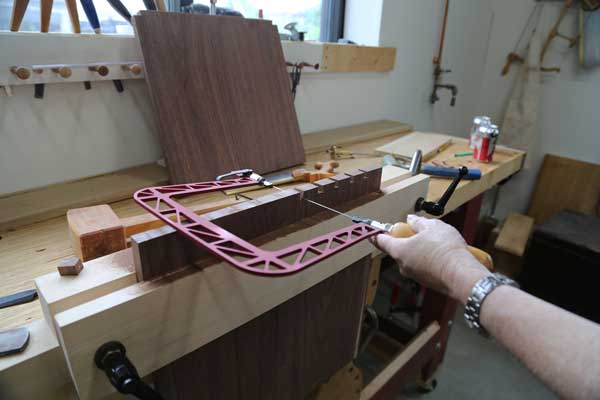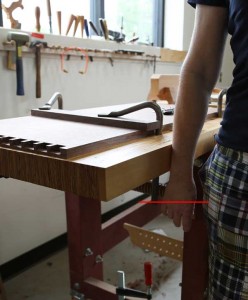We may receive a commission when you use our affiliate links. However, this does not impact our recommendations.
 Note the wheel in the lower right corner – ouch.
Note the wheel in the lower right corner – ouch.
No, I didn’t drop a chisel on my foot or get bit by the table saw. But I did run into challenges of several sorts in the shop this weekend while working on a Shaker blanket chest with half-blind dovetails for an upcoming issue, and I had no recourse but to compensate for less-than-ideal conditions (which I suspect is something many of us have to do in the shop from time to time).
A few years back, Christopher Schwarz added wheels to my LVL Workbench (a bench he and I built for the Nov. 2009 issue). The wheels are a great modification – especially when the bench needs to be moved the 50 yards from the shop to the photo studio, because LVL is incredibly heavy stuff. The wheels can be flipped out of the way so that the bench drops back down onto its legs to bring it to my preferred working height, which is 29″ (note that the dimensions given in the article for the bench are sized to a woodworker of a more average height). But the bench was on its wheels – and, again, LVL is incredibly heavy stuff; I am physically incapable of lifting my bench enough to flip the wheels out of the way (heck – I can barely lift it at all), and I couldn’t ask someone to come in just to make my life easier.
So I was stuck sawing and chopping dovetails at about 5″ higher than is comfortable for me.
When sawing, I had to compensate both with the trajectory of my sawing arm and my wrist angle – which meant that I tired out more quickly because unaccustomed muscles were in play.
Chopping took even more compensation, in terms of extra time – I couldn’t achieve my usual (admittedly wimpy) mallet swing because I had 5″ less room between the top and bottom of the action (yes, 5″ makes a heck of a difference – at least to me); I figure each half-pin socket took me at least a third longer than usual to clean out because I had to make a few extra cuts on each to reach the baseline. And paring to remove waste in the corners was more of a challenge, too, because I couldn’t get all the way over the work to use my full body weight behind the chisel. Very tiring.
And now, two days later, my shoulders hurt. A lot.
But both the sawing and the chopping challenges are easily solved – I simply have to ask Bob Lang and Glen Huey to help me out and get my bench back to working height.
The bigger challenge, though, is that my eyes (and the rest of me, I suppose) are fast approaching decrepitude; I can no longer focus close up, even with my reading glasses. Today, I went to the eye doctor, assuming the easy fix was a new prescription. And it is – but those glasses would be clear only for very close work (less than 10″)…such as dropping a chisel into a knife line on walnut. Then, I’d have to switch to my “regular” reading glasses for the bulk of the work, no doubt dropping my chisel out of the knife line as I fumble with the specs change. (And then switch to my distance glasses to walk from the shop to the office if I want to clearly see the path.) That seems silly; I need that ultra-close focus for about 1 percent of my week.
Instead, I’m going to invest in an additional bench light and play around with raking angles, in hopes that will make things a little easier to see from a little farther away. And, I’m going to score my layouts more deeply with the cutting gauge and marking knife, so I can more easily find things by feel. Both should help me compensate – at least for a few years, until I break down and buy trifocals. Or begin to work only in light-colored woods, on which layout lines are easier to see.
p.s. Note that bench height is up there with pins first vs. tails first for fomenting debate. The picture above shows what works for me (or really, what doesn’t work for me) – a 5’6″ predominantly hand-tool user who owns metal-bodied planes. There are no hard and fast rules; there are a lot of opinions. I have no dog in this fight. Or cat.
p.p.s. If you want to read more about the “perfect” bench how to make a bench that’s perfect for you, I recommend “The Workbench Design Book” (which also includes the LVL bench).
Here are some supplies and tools we find essential in our everyday work around the shop. We may receive a commission from sales referred by our links; however, we have carefully selected these products for their usefulness and quality.











Meghan, rather than lowering the bench, how about making a 41/2″ platform that will fit under the bench and bringing yourself to within 1/2″ of your prefered working height. joe
Maybe you should keep a small scissor jack in the shop to lift your bench so you can adjust the wheels.
http://blindwoodworker.com/
Megan, check out your shipping department and see if they have a johnson bar that you can use. Anyone who moves heavy stuff ( like boxes of books ) is likely to have one. If not, they’ll have a pallet jack and you can use that. Don’t try to use a fork lift unless the shipping manager gives you the ok.
cobbling together a temporary 5 in platform should have been easy work for someone who c an make half-blind dovetails!
Megan
The bench has cross braces running it`s length. Determine the distance below them to the ground and buy a jack that will fit under it to help raise it up, Link below is 8.25: tall, but they come in all sizes, and flavors.
http://www.harborfreight.com/automotive-motorcycle/bottle-jacks/12-ton-heavy-duty-industrial-hydraulic-bottle-jack-69476.html
For your Granny eyes, forget correction, go with magnification, specifically table mounted magnification.
http://www.telesightmagnifiers.com/id151.html
CVS has everything else in the convalescence aisle, walkers, those industrial strength panty liners and all the rest, You`ll be good as a 70 year old in just a few weeks. Remember just keep pushing, if ya quit, well it`s all sliding downhill from there 🙂
On the glasses issue, I’ve found that in progressives, all of the gradual focal length change takes place in what would otherwise be the reading section of a bifocal lens, thus reducing the actual useful reading section to less than that of a bifocal. The bad news: the need to slightly shift my head sideways when reading page-width lines instead of columns. The good news: no sudden jump in focus, and more of the floor is reasonably in focus when walking around.
Instead of going to a junkyard or stealing the jack from your car, is there some structure of the bench (too lazy to dig out the old mag) that is low enough that you could put a block of wood in front of it as a fulcrum and use a length of 2×4 as a lever that you could step on to raise your bench enough to switch the wheels? For some things, I’ve even found that it’s possible to slightly shift the position of whatever by moving my foot sideways while the near legs are off the floor.
Megan,
I’m 71 and love my progressive lenses which I have had for years but I also keep several Optivisors handy for close work. I found them cheap at estate sales but they are available from several sources. They are less expensive than Lie-Nielsen’s Magni-Focuser and work much the same way. Love your magazine and your writing.
I got a Magni-Focuser for when I do some carving and detail work — works well over my glasses. (Was recommended to me by Janet Collins who also uses it a lot)
It works great and can be flipped up out of the way sort of like a welding mask.
I bought mine from Lie-Nielsen; it was reasonably priced and still made in the USA.
http://www.lie-nielsen.com/catalog.php?sku=2-MF-104
Hi Megan,
TJ noted he got progressive lenses and could not get used to them. It takes a month or more for your brain to retrain itself so you unconsciously correct your eye position through the lenses. But after the initial pain it is as close as you can get to having normal eyesight again. No fixed focal points like bifocals or trifocals have. I hate eyeglasses because of the dust , dirt and smudges that are always on them. At 55 I would love to be able to go back to my youth when I had perfect eyesight. But that’s not going to happen and progressives are the next best option.
Take Care, Dave
I use a visor-style magnifier when I need that extra little bit. Easy to put on and take off, much easier than changing eyeglasses.
-Steve
Stand on a box.
What kind {or make} of screws and handles did you use to make your moxon vise?
I have the same issue with my 55 year old eyes. I have to have a pair for working on the computer and another for reading. Distance is good for the moment. I got a pair of progressive lenses and never got used to them.
I have a magnifying glass/light at my workbench for those very close up needs.
TJ
Hey Megan,
Next time you’re at the junk yard, pick up a used car jack. Should be a lot easier than calling Bob or Glen in on a weekend…
Megan,
Do what I did. Get tri-focals. Not sexy, but I can see well at all distances I need to.